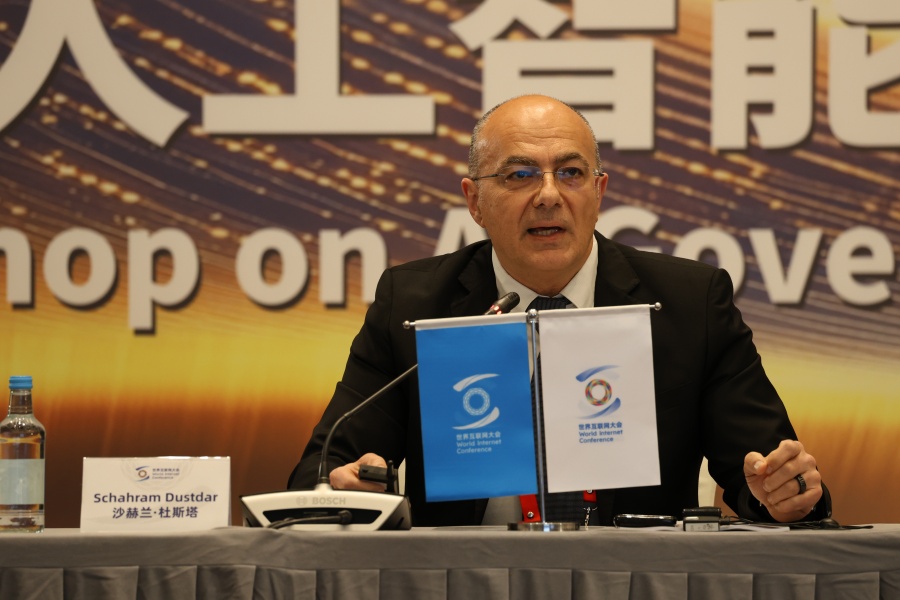
- Home
- Media Center
-
Events
- Wuzhen Summit
- Regional Forums
- Practice Cases of Jointly Building a Community with a Shared Future in Cyberspace
- World Internet Conference Awards for Pioneering Science and Technology
- The Light of Internet Expo
- Straight to Wuzhen Competition
- Global Youth Leadership Program
- WIC Distinguished Contribution Award
- Membership
- Research & Cooperation
- Digital Academy
-
Reports
- Collection of cases on Jointly Building a Community with a Shared Future in Cyberspace
- Collection of Shortlisted Achievements of World Internet Conference Awards for Pioneering Science and Technology
- Reports on Artificial Intelligence
- Reports on Cross—Border E—Commerce
- Reports on Data
- Outcomes of Think Tank Cooperation Program
- Series on Sovereignty in Cyberspace Theory and Practice
- Other Achievements
- About WIC
- 中文 | EN

Workshop on AI Governance and Sustainable Development|Schahram Dustdar: Distributed AI infrastructure should be a continuum

Schahram Dustdar, co-chair of the World Internet Conference (WIC) Specialized Committee on Artificial Intelligence, a member of Academia Europaea, fellow of the Institute of Electrical and Electronics Engineers and a professor at the Vienna University of Technology, speaks at the Workshop on AI Governance and Sustainable Development during the WIC Asia-Pacific Summit in Hong Kong on April 14. [Photo/wicinternet.org]
Artificial intelligence (AI) infrastructure should be a continuum, as stated by Schahram Dustdar, co-chair of the World Internet Conference (WIC) Specialized Committee on AI, at the "AI Governance and Sustainable Development: for Good and for All" Workshop during the WIC Asia-Pacific Summit in Hong Kong on April 14.
Dustdar, also a member of Academia Europaea, a fellow of the Institute of Electrical and Electronics Engineers and a professor at the Vienna University of Technology, said that the data training of large language models consumes a significant amount of energy, rendering them unsustainable.
He introduced the concept of the "computing continuum" at the workshop, which is a type of computation performed by a computing structure composed of computing layers.
He said that in many applications used for health monitoring and smart cities, AI runs in a distributed manner on different infrastructures. This raises a fundamental question of how to share distributed, rather than centralized intelligent infrastructure, he noted.
"Different stakeholders and operators all have their own interests. These stakeholders with varying interests are also geographically dispersed. This means that centralizing the management of infrastructure is extremely challenging," he said. On the other hand, centralizing AI infrastructure, from either a political or technical perspective, could impose burdens on the sustainable development of society, he added.
He emphasized the need for AI structure to be a seamless continuum, where the spectrum, sensors, Internet of Things, edge computing and cloud computing collaborate to drive advancements in AI development.
Furthermore, he highlighted how the concept of a computing continuum can address security issues in AI development. Managing the full-lifecycle of AI, from preprocessing and training to evaluation, deployment and model monitoring, is intricate and often centralized, resulting in high costs, according to him. By transitioning to AI infrastructure management under the computing continuum concept, where data providers can manage various models in a modular form, end-users will gain flexibility to deploy AI models efficiently and cost-effectively, he added.

The World Internet Conference (WIC) was established as an international organization on July 12, 2022, headquartered in Beijing, China. It was jointly initiated by Global System for Mobile Communication Association (GSMA), National Computer Network Emergency Response Technical Team/Coordination Center of China (CNCERT), China Internet Network Information Center (CNNIC), Alibaba Group, Tencent, and Zhijiang Lab.





